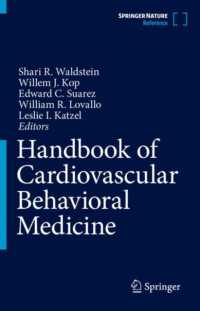基本説明
初版1960年発行の動脈の血流力学研究の定本。本書の特長である、科学的な基礎に根ざした議論、実践への応用、包括的で緊密なスタイルはそのままに、内容を改訂。5年ぶりの改訂版。
The 50th anniversary since the first edition, McDonald's Blood Flow in Arteries continues to remain the definitive reference work in arterial haemodynamics by combining a sound scientific base with a focus on practical clinical applications. New for the Sixth Edition: Covers all recent developments in the field ensuring this is the most comprehensive and up-to-date reference for clinicians; An abundance of illustrations throughout to aid understanding and clarify key principles. Previous ed.: 2005.
Full Description
For over fifty years, McDonald's Blood Flow in Arteries has remained the definitive reference work in the field of arterial hemodynamics, including arterial structure and function with special emphasis on pulsatile flow and pressure. Prestigious, authoritative and comprehensive, the sixth edition has been totally updated and revised with several new chapters. This edition continues to provide the theoretical basis required for a thorough understanding of arterial blood flow in both normal and pathological conditions, while keeping clinical considerations and readability paramount throughout the text.
New for the sixth edition
McDonald's groundbreaking waveform analysis is extended to explain ill effects of aging on the aorta and heart, and on the small blood vessels of vital organs - brain and kidneys.
Rigorous theory and methodology are combined to show relevance of blood pressure and flow pulsations to individual clinical problems and to results of the most recent epidemiological studies and clinical trials.
Written by a small tightly-knit group to provide consistency and easy reference of normal and abnormal functions in arteries of all sizes in humans, experimental animals, and realistic computer models.
Now available in a digital version, together with this book, to provide instant access to this invaluable reference resource.
Erudite, definitive yet thoroughly practical, McDonald's Blood Flow in Arteries is essential reading for modern cardiologists, intensive care physicians, anesthesiologists, gerontologists, diabetologists, nephrologists and neurologists as well as physiologists, pharmacologists and epidemiologists.
Contents
The nature of flow of a liquid. Properties of the arterial wall: theory. Properties of the arterial wall: practice. Endothelial function. General principles for measuring arterial waves. Pulsatile pressure-flow relations. Ultrasound. Wave reflections. Contours of pressure and flow waves in arteries. Principles of recording and analysis of arterial waveforms. Vascular impedance. Aortic input impedance as ventricular load. Coupling of the left ventricle with the systemic circulation: implications to cardiac failure. Cardiac failure: clinical implications. The pulmonary circulation. The coronary circulation. Special circulations. Aging. Hypertension. Interpretation of blood pressure in epidemiological studies and clinical trials. Arterial biomarkers. Atherosclerosis. Specific arterial disease. Generalized and metabolic disease. Therapeutic strategies. Exercise. Central arterial pressure. Lifestyle and environment. Pressure pulse waveform analysis.







